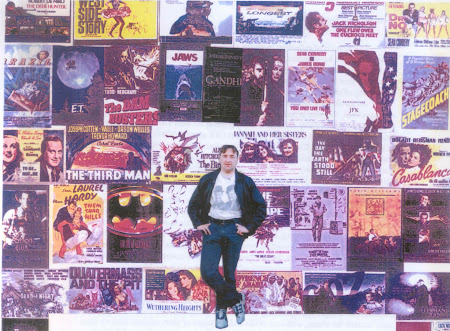At the National Museum of Photography, Film and Television in Bradford - or the National Media Museum as it's now more simply known - is contained a slightly withering original print of the first film produced in Cinerama, It is shown at the museum's adjacent Pictureville Cinema every first Saturday of the month. The Pictureville is - in point of fact -
 the only remaining facility in the world that shows the original 3-strip, triple projection Cinerama format.
the only remaining facility in the world that shows the original 3-strip, triple projection Cinerama format.The process began officially in 1952 with this demonstration film, but the evolution of Cinerama stems as far back as the 1920s, when Abel Gance experimented with many photographic innovations for his 1927 epic Napoleon, with a finale where one standard image became three in a giant triptych, creating a glorious panorama. Other widescreen experiments came along in thesubsequent decades, including a 1940s John Wayne Western, The Big Trail, which didn't catch on, largely because of the scarcity of the equipment required to project the film in general theatres.
Come the 1950s however, and a new menace to cinema had arrived in the shape of television. To combat the threat many Hollywood studios looked to some of their earlier experiments, and most of them were struck in awe by the success of the fledgling new Cinerama company, and their debut demonstration film This is Cinerama in 1952.
The opening of the film feels like witnessing the first telephone conversation by Thomas Edison or the first TV broadcast by John Logie Baird - or indeed the first words spoken by Al Jolson in The Jazz Singer - all of which such pioneering achievements are referred to in the opening
 prologue presented and narrated by one Lowell Thomas, then a distinguished radio newscaster and noted chronicler of the adventures of T.E. Lawrence, and now unwittingly the first "star" as such to be seen in Cinerama. Walking around his office in a conventional 35mm black & white frame, Thomas introduces himself to the premiere audience of that first momentous screening in September 1952 (and all subsequent screenings of the film), declaring to the audience with great gusto "this is Cinerama!".....
prologue presented and narrated by one Lowell Thomas, then a distinguished radio newscaster and noted chronicler of the adventures of T.E. Lawrence, and now unwittingly the first "star" as such to be seen in Cinerama. Walking around his office in a conventional 35mm black & white frame, Thomas introduces himself to the premiere audience of that first momentous screening in September 1952 (and all subsequent screenings of the film), declaring to the audience with great gusto "this is Cinerama!".....
...and suddenly the single black & white image transforms into three vibrant colour images on the giant screen - almost as far as the average human's peripheral vision - and the audience finds itself on the front seat of a giant rollercoaster. Seated in the front row of the auditorium (as I was at the Pictureville), with the curved screen surround, gives all the impression of riding on the rollercoaster itself, without the cinema seats having moved one inch!
The exhilarating opening few minutes on the rollercoaster are the undoubted highlight of the film (and the doubtless inspiration for thousands of funfair simulation rides), but there's much else to enjoy, starting with the now in full colour and three-screen Cinerama Lowell Thomas, as he takes us on a journey around some of the sights and sounds of the world in all its spectacle, which include Venice, La Scala Opera in Milan, a Highland Games in Scotland, and most curiously, a Florida theme park at Cypress Gardens in Lake Eloise, with a motorboat and water ski display, the water skis ridden by several "Aquabelles" who sit around the park looking pretty the rest of the time. One of them in particular, is named "Toni", and clearly has elements of Scarlett O'Hara's feistiness about her. To my surprise and disappointment, I can find absolutely no record of the actress who plays this particular part, in what is in effect, the first dramatic character performance in a Cinerama film.
The finale is one of the best advertisements for America that I know, as the Cinerama cameras take a helicopter ride all the way from East Coast to West (parts of which were also used for the finale of How the West was Won), with a stirring soundtrack of American music (partly scored by Max Steiner). This is Cinerama is perhaps a bit of museum piece nowadays, especially in the light of subsequent big screen developments which came along in 50s - such as 70mm Cinemascope, Todd AO (developed by one of this film's producers, Michael Todd), Panavision, Technirama, and now most recently IMAX - but it's worth noting that the widescreen revolution began in earnest right here. It's also a nice slice of the 1950s, and for me, I find it a lot of fun to watch those three images trying to keep together, and it's often breathtaking when they do. Treat yourself to a day out in Bradford to watch it.

See also in70mm.com article



1 comment:
Footnote: The "Toni" in question in the Southern Belles sequence is Toni Valk
Post a Comment